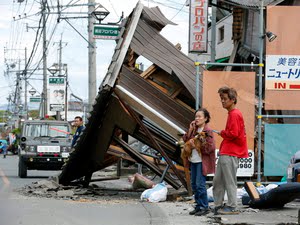
Tokyo – Rescuers were scrambling to find survivors Sunday following two large earthquakes that hit the southern Japanese island of Kyushu, killing 41 people, while aftershocks continued to shake the region.
Japan boosted search and rescue operations after heavy rain pounded Kyushu overnight and further complicated recovery work in the mountainous areas of the island.
About 10 people were unaccounted for in Minamiaso village in Kumamoto prefecture, where the quakes triggered a large landslide, local police officials said.
More than 110,000 residents were evacuated to makeshift shelters, broadcaster NHK reported, as the authorities said nearly 400 houses were completely destroyed and about 1,300 severely damaged.
Some of them told Japanese media they now had nowhere to go as their houses were demolished.
Many evacuees spent more than an hour lining up for relief supplies while more food and daily necessities were sent to quake-stricken areas in the prefectures of Kumamoto and Oita.
“I ordered (relevant ministries) to ensure supplies of food, medicine and water to those who have been evacuated and spent a worrying night at shelters,” Prime Minister Shinzo Abe told reporters in Tokyo.
Across Kumamoto, about 56,000 households suffered power outages, according to NHK.
Gen Aoki, director of the earthquake and tsunami department of the meteorological agency, warned of more aftershocks and mudslides in the region.
More than 450 quakes have rattled Kyushu since the first big tremor with a magnitude of 6.5 in Kumamoto on Thursday evening. A magnitude-7.3 earthquake struck the same region early Saturday, according to the Meteorological Agency.
The quakes prompted the closure of some highways on the island and the suspension of some train services, including high-speed bullet trains.
Airline companies cancelled their flights to and from Kumamoto Airport after a ceiling collapsed at the facility.
Defence Minister Gen Nakatani said late Saturday that the number of troops dispatched to the region would rise to 25,000, with thousands already on site.
The government said there were no abnormalities at four nearby nuclear power stations.
The two major quakes were the largest since the earthquake and resulting tsunami in north-eastern Japan on March 11, 2011, which prompted the shutting down of all of its workable reactors in the months that followed.
Those twin natural disasters left about 18,500 people dead and caused a triple meltdown at the Fukushima Daiichi Nuclear Power Station.
Earthquake-prone Japan sits at the convergence of four tectonic plates. The country is also home to more than 100 active volcanoes.
[Source:- DPA]



